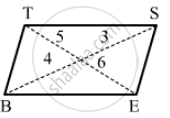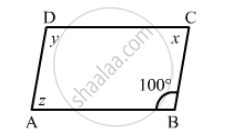Advertisements
Advertisements
Question
Can the following figure be parallelogram. Justify your answer.

Solution
\[\text{ No, This is because the diagonals do not bisect each other } .\]
APPEARS IN
RELATED QUESTIONS
Name the quadrilaterals whose diagonals are perpendicular bisectors of each other
The following figure is parallelogram. Find the degree values of the unknowns x, y, z.

In a parallelogram ABCD, ∠D = 135°, determine the measure of ∠A and ∠B.
Which of the following statement is true for a rhombus?
It has two pairs of equal sides.
Fill in the blank, in each of the following, so as to make the statement true:
If the diagonals of a parallelogram bisect each other at right angles, then it is a ......
Lengths of diagonals of a rhombus ABCD are 16 cm and 12 cm. Find the side and perimeter of the rhombus.
The given figure shows a rhombus ABCD in which angle BCD = 80°. Find angles x and y.

The lengths of the diagonals of a Rhombus are 12 cm and 16 cm. Find the side of the rhombus
A rhombus is a parallelogram in which ______ sides are equal.
All rhombuses are squares.
